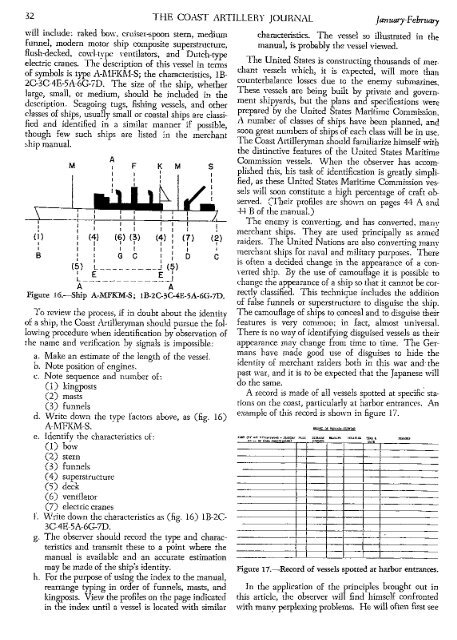January-February - Air Defense Artillery
January-February - Air Defense Artillery
January-February - Air Defense Artillery
You also want an ePaper? Increase the reach of your titles
YUMPU automatically turns print PDFs into web optimized ePapers that Google loves.
32<br />
will include: raked bow, cruiser-spoon stern, medium<br />
funnel, modern motor ship composite superstructure,<br />
Hush-decked, cowl-type ventilators, and Dutch-type<br />
electric cranes. The description of this vessel in terms<br />
of symbols is type A-l\IFKM-S; the characteristics, IB-<br />
2G3G4E-5A-6G-7D. The size of the ship, whether<br />
large, small, or medium, should be included in the<br />
description. Seagoing tugs, fishing vessels, and other<br />
classes of ships, usually small or coastal ships are classified<br />
and identified in a similar manner if possible,<br />
though few such ships are listed in the merchant<br />
~hip manual.<br />
I<br />
1<br />
(I )<br />
I<br />
I<br />
B<br />
Figure<br />
M<br />
To review the process, if in doubt about the identity<br />
of a ship, the Coast <strong>Artillery</strong>man should pursue the following<br />
procedure when identification by observation of<br />
the name and verification by signals is impossible:<br />
a. Make an estimate of the length of the vessel.<br />
b. Note position of engines.<br />
c. Note sequence and number of:<br />
0) kingposts<br />
(2) masts<br />
(3) funnels<br />
d. Write down the type factors above, as (fig. 16)<br />
A-MFKM-S.<br />
e. Identify the characteristics of:<br />
0) bow<br />
(2) stern<br />
(3) funnels<br />
(4) superstructure<br />
(5) deck<br />
(6) ventilator<br />
(7) electric cranes<br />
f. \\7rite down the characteristics as (fig. 16) 1B-2C-<br />
3C-4E-5A-6G-7D.<br />
g. The observer should record the type and characteristics<br />
and transmit these to a point where the<br />
manual is available and an accurate estimation<br />
may be made of the ship's identity.<br />
h. For the purpose of using the index to the manual,<br />
rearrange typing in order of funnels, masts, and<br />
kingposts. View the profiles on the page indicated<br />
in the index until a vessel is located \\'ith similar<br />
F<br />
THE COAST ARTILLERY JOURNAL<br />
K M<br />
I<br />
I<br />
I<br />
I I<br />
I I I<br />
I I I<br />
I I I<br />
(4) (6) (3) (4) (7) (2)<br />
I I I I I I<br />
I I I J t I<br />
I Gel 0 C<br />
I I<br />
(5) L .J (5)<br />
lEE I<br />
L J<br />
A A<br />
16.-Ship A-MFKM-S; IB-2C-3C-4E-SA-6G-7D.<br />
<strong>January</strong>-<strong>February</strong><br />
characteristics. The vessel so illustrated in the<br />
manual, is probably the vessel viewed.<br />
The United States is constructing thousands of merchant<br />
vessels which, it is expected, \vill more than<br />
counterbalance losses due to the enemy submarines.<br />
These vessels are being built by private and government<br />
shipyards, but the plans and specifications were<br />
prepared by the United States Maritime Commission.<br />
A number of classes of ships have been planned, and<br />
soon great numbers of ships of each class will be in use.<br />
The Coast <strong>Artillery</strong>man should familiarize himself with<br />
the distinctive features of the United States Maritime<br />
Commission vessels. When the observer has accomplished<br />
this, his task of identification is greatly simplified,<br />
as these United States Maritime Commission vessels<br />
will soon constitute a high percentage of craft observed.<br />
(Their profiles are shown on pages 44 A and<br />
-14B of the manual.)<br />
The enemy is converting, and has converted, manv<br />
merchant ships. They are used principally as armed<br />
raiders. The United Nations are also converting many<br />
merchant ships for naval and military purposes. There<br />
is often a decided change in the appearance of a con-<br />
"erted ship. By the use of camouHage it is possible to<br />
change the appearance of a ship so that it cannot be correctly<br />
classified. This technique includes the addition<br />
of false funnels or superstructure to disguise the ship.<br />
The camouHageof ships to conceal and to disguise their<br />
features is very common; in fact, almost universal.<br />
There is no way of identifying disguised vessels as their<br />
appearance may change from time to time. The Germans<br />
have made good use of disguises to hide the<br />
identity of merchant raiders both in this war and-the<br />
past \Y~r,and it is to be expected that the Japanese will<br />
do the same.<br />
A record is made of all vessels spotted at specifi~stations<br />
on the coast, particularly at harbor entrances. An<br />
example of this record is shown in figure 17_<br />
Figure 17.-Record of vessels spotted at harbor entrances.<br />
In the application of the principles brought out in<br />
this article, the observer will find himself confronted<br />
with many perplexing problems. He will often first see
















